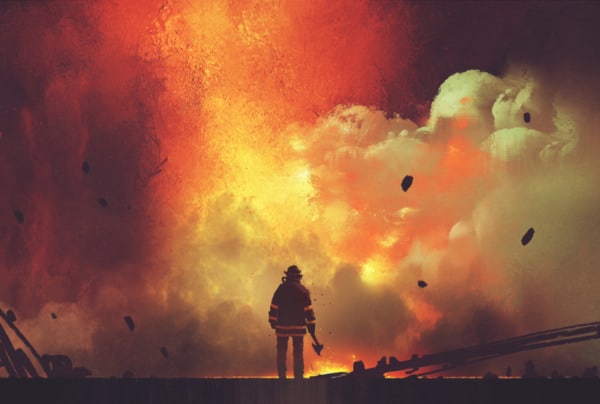Fiery tragedies have driven sweeping changes to fire and building codes
The Iroquois Theater Fire. The Triangle Shirtwaist Fire. Our Lady of the Angels School Fire. The Station Nightclub Fire. The destruction caused by these and many other of the deadliest fires in U.S. history was horrific.
But America is a nation that’s built on resilience. And painful lessons emerged from each devastating event, shaping new fire safety regulations that have saved countless lives and made modern life drastically safer.
Since its inception in 1896 to standardize the design and installation of fire sprinkler systems, the non-profit National Fire Protection Agency (NFPA) has focused on reducing deaths, injuries, and property and economic losses caused by fire. It describes its codes and standards as living documents that never age. They are continually updated with new information based on fire experience and research that enable them to keep pace with a changing world.
In this first installment of our series on lessons learned from some of the deadliest fires in U.S. history, we examine the Iroquois Theater and Triangle Shirtwaist fires—how these early-20th-Century fires spurred requirements for fire sprinklers, better egress routes, alarm and detection systems, reducing the flammability of interior finishes, and other critical protections.
In the market for fire protection? Feel free to browse our selection of sprinkler system components and accessories, including commercial and residential sprinkler heads, installation tools, fire extinguishers, heavy-duty head guards that protect sprinklers from accidental damage or vandalism, and so much more.
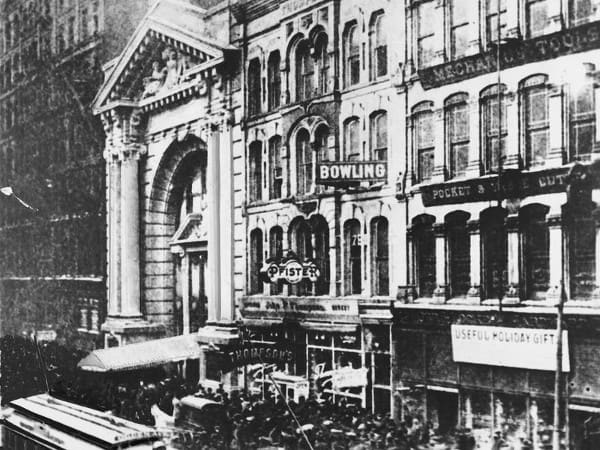
The Iroquois Theater Fire: Chicago, 1903
About three decades after the Great Fire ravaged Chicago in 1871 and killed 250 people, the city proved it still had many lessons to learn about fire safety. On Dec. 30, 1903, the ornate, five-week-old Iroquois Theater was filled beyond its capacity with an audience comprised of mostly women and children from Chicago’s upper-middle-class society. People had traveled for miles to see Mr. Blue Beard, an over-the-top musical comedy resplendent with scenes from around the world, actors dressed as animals, and a suspended ballerina.
Nearly a third of the 1,700 patrons would never make it out. This tragedy served as a wake-up call to the city and the nation about the need to enforce tougher fire codes, inspiring federal and state overhauls of regulations that govern public spaces.
What went wrong
As the show began its second act around 3:15 p.m., a spark from a stage light ignited nearby drapery. The fire tore across the flammable decorative backdrops after attempts to stamp it out with a primitive retardant proved futile.
Despite proudly marketing the theater as “fireproof,” producers had flouted nearly every fire code in their haste to open before the holidays. Every seat in the house was filled and standing ticket holders clogged the aisles. Nailed-off vents on the rooftop trapped the smoke and heat inside. The theater lacked an adequate fire alarm, automatic sprinklers, marked exits, or suitable fire extinguishing devices.
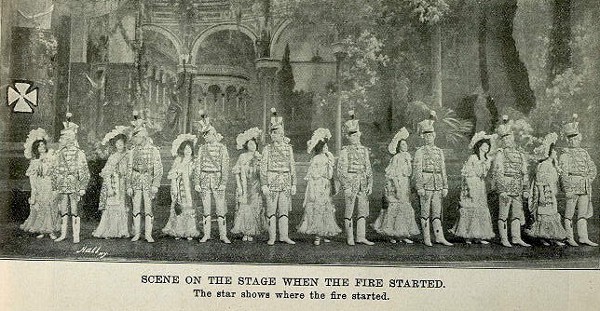
Panicked audience members bolted toward the few exits they could find, but the vast majority—27 of the 30 exit doors—were blocked with curtains or locked. People in the upper levels quickly discovered they were trapped behind metal accordion gates, quietly locked after the show started to keep them from sneaking down into pricier seats.
A few spotted an upper-level fire escape, only to realize it lacked a ladder to the ground. Cast members opened a rear stage door to escape—leaving the suspended ballerina trapped in her rigging—and the backdraft triggered a fireball that instantly killed many of the people locked in the balconies.
It took firefighters less than 20 minutes to extinguish the blaze. But the scene they discovered was gruesome and tragic. More than 602 people perished in the fire, many of them stacked in piles that climbed as high as 12 feet against the locked exits. NFPA ranks the tragedy as the fifth-deadliest fire in our nation’s history and the worst theater tragedy.
Watch this video to learn more about the fire and its aftermath. Warning: some images may be disturbing:
Why theaters and other public buildings are safer after the Iroquois Theater Fire
Within days, Chicago shuttered all theaters in its jurisdiction until city officials could be assured that they offered better protection against fires—and cities nationwide followed its lead. Within weeks, Chicago had passed a new building ordinance that led to enduring fire safety changes in theaters and other public spaces, including new standards stipulating:
- Clear pathways
- Clearly marked exits
- Doors that were unlocked and easy to open
- A fireproofing solution for theater backdrops
- Fire alarms connected to local fire stations
- Fire sprinkler requirements
- Ventilation standards to prevent fireballs and smoke buildup
- Maximum seating capacities to prevent crushing crowds
- The elimination of “standing” tickets.
For the first time, rules pertaining to the lighting of exits, aisles, and corridors in dark theaters were also mandated, including a requirement that a red light continuously burns over the exits during shows. Fire safety advocates also pushed for these exit lights to have a back-up source of power—a critical change since the fire quickly melted the electrical circuits at the Iroquois and plunged the theater into darkness.
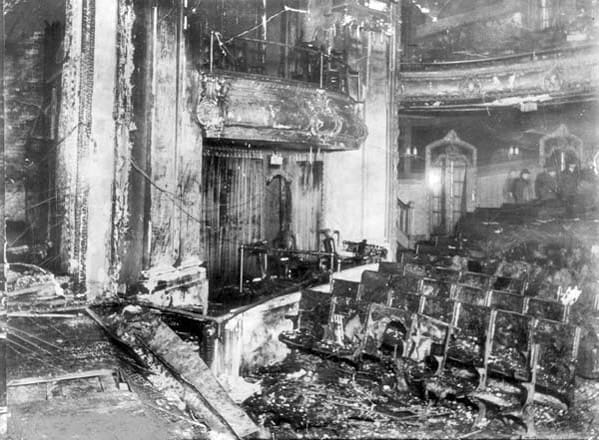
The Iroquois tragedy also led to the invention of panic bars, a crash bar mechanism on doors that prevents entry from the outside—the reason ticket sellers locked theater exits—but can be easily opened under duress. The panic bar was created by a hardware salesman who had originally planned to attend the performance of Mr. Bluebeard on the day of the fire.
But no matter how many protections are in place, human behavior remains the biggest variable in fire protection. The loss of so many people to such a preventable tragedy—especially so many children—forced city officials nationwide to take a hard look at how they regulate large public spaces, and started a long inquiry into how strictly life-saving rules are enforced.

The Triangle Shirtwaist Fire: New York City, 1911
Another preventable tragedy shocked the nation a few short years later. The Triangle Shirtwaist Company manufactured women’s blouses on the top three floors of a 10-story building in Manhattan. By today’s standards, it would easily qualify as a sweatshop, with workers who were mostly immigrant women and children as young as 12 from Italy, Germany, and Eastern Europe laboring through 14-hour daily shifts for about $7 a week.
What went wrong
By all accounts, the Triangle Shirtwaist factory was an accident waiting to happen—and its dangerous conditions were unfortunately common for the time. Flammable textiles were stored throughout the building and thousands of pounds of scraps littered the floors and overflowed from bins. At the time of the fire, the rags had reportedly not been cleared for two months.
People smoked cigarettes at their desks and carelessly tossed the butts into rag bins instead of ashtrays. Bin fires occurred so often that buckets of water stood ready throughout the factory.
Most of the exit doors were locked during business hours to prevent theft, and only a few were opened when the quitting bell rang, forcing employees to line up and leave single file so a supervisor could check for stolen supplies. Two years before the fire, a fire inspector had pointed out that locking the doors was a risk—and also recommended fire drills through the factory’s narrow aisles and the removal of partitions that blocked doors and elevators. Factory owners ignored his advice.
It was almost quitting time on March 25, 1911, when someone on the 8th floor yelled, “Fire!” A man grabbed a bucket of water and threw it on the burning rag bin, but flames were already licking the paper patterns hanging overhead.
Within minutes, the entire 8th floor was ablaze. Terrified employees crammed themselves into the single, small elevator and onto the narrow fire escape, which ripped from the building under their weight and sent dozens of bodies hurtling to the courtyard below.
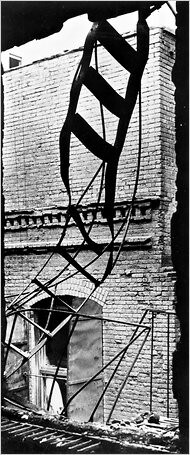
At the time, fire codes only required less-flammable metal window frames and stone floors for buildings with 11 or more stories. Thus, the 10-story Triangle factory was constructed with wood floors, wood trim, and wood window frames that fueled the flames.
An architect had convinced city officials to permit two staircases instead of the three normally mandated on every floor in similarly sized buildings because there was an outside fire escape. But even before it collapsed, the fire escape had a two-story drop-off, failing to deliver people safely to the ground.
The architect also convinced the city to permit doors that opened inward instead of outward, claiming there otherwise wasn’t enough clearance to the stairs. When the fire broke out, panicked workers piled up against the doors, making it nearly impossible for those who arrived first to open them.
First responders were torn between extinguishing the flames and trying to catch the more than 50 women jumping from the windows to escape the smoke and searing heat. Tragically, their rescue ladder proved useless: it could only extend about six stories.
It took 18 minutes to bring the fire under control once other fire departments arrived. But by then, about 147 of the factory’s 500 workers had perished, making it one of the deadliest fires in U.S. history. Most of the casualties were on the 9th floor; the 10th-floor executives had been quickly warned and called for the elevator. But in the panic that ensued, no one informed workers on the middle floor about the fire until flames burst through the windows.
Watch this brief CBS News documentary to learn more about the Triangle Shirtwaist Fire. Warning: some images are graphic and may be disturbing:
Why workplaces and high-rise buildings are safer after the Triangle Shirtwaist Fire
It’s arguable that no fire has had a greater impact on fire safety than the Triangle tragedy. Horrific images of piles of charred corpses and desperate women leaping to their deaths from windows were seared into the public consciousness. The Triangle fire spurred reforms in New York that spread nationwide, including outward-swinging doors and fire sprinklers in high-rise buildings.
Fueled by public outrage, the governor of New York created a commission to examine working conditions at all New York City factories, leading to 36 new laws aimed at reforming the state labor code. Within a year, New York City had also created the country’s first fire prevention bureau within its fire department. Its inception helped revolutionize urban fire safety standards, making it harder for greedy or uninformed property owners to ignore fire codes. It established an oversight agency charged with inspecting businesses and making sure they complied with new and important laws like not locking doors during working hours.
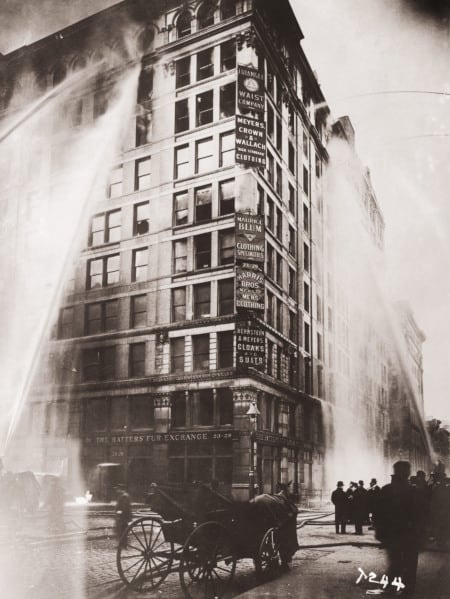
The Triangle Shirtwaist Fire also spurred NFPA to form the Committee on Safety to Life, devoted exclusively to life safety concerns. In 1914, at the NFPA annual meeting, the committee delivered its first report that included a special section on egress, a statement that sprinklers can save lives, and preliminary specifications for outside fire escapes.
In 1927, the committee rolled out the first edition of NFPA 101: Life Safety Code, then called the Building Exits Code. At first, the new code zeroed in on the hazards of stairways and fire escapes, the need for fire drills in various occupancies, and the construction and arrangement of exits.
But as new technologies emerged, properties evolved, and fire experience grew, provisions were added to include related life safety features for fires in all classes of occupancy, including fire sprinklers and alarm and detection systems. Today, the Life Safety Code stands as a landmark document that covers numerous aspects of life safety in new and existing structures.
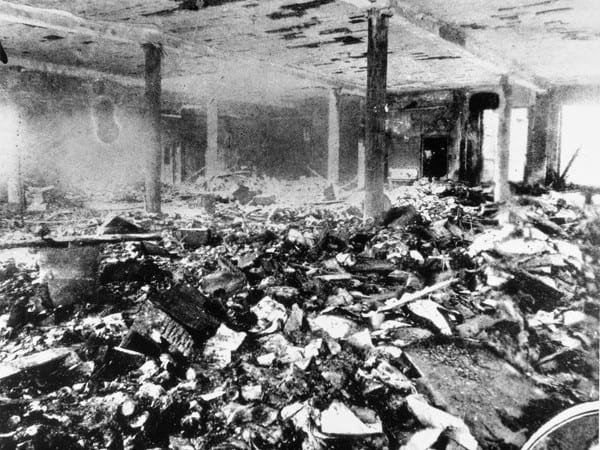
Fire protection: an evolving effort to keep people and property safe after the deadliest fires in U.S. history
Fire protection is an ongoing effort—and fire protection professionals diligently study the lessons of history to shape fire and building codes that can protect people and property from tragic outcomes.
Setting sky-high fire safety standards and holding buildings to them is the safest course of action. But unfortunately, hindsight is 20/20 and people are often resistant to proposed regulations they view as too restrictive or expensive to implement.
As a result, most modern fire codes exist because of tragic events like the Iroquois Theater and Triangle Shirtwaist fires that finally convince people that there’s a wrong way to build things—and property owners have an urgent responsibility to keep people safe. Unfortunately, these lessons are never completely learned, as the use of highly flammable aluminum cladding in London’s Grenfell Tower and other buildings illustrates. The 2017 Grenfell Tower Fire killed 72 people and injured more than 70 others, spurring another look at fire safety improvements that can prevent future tragedies.
Stay tuned for part two of our series, where we examine the Our Lady of the Angels School Fire and The Station Nightclub Fire—and how those tragedies helped make schools and public assembly occupancies safer.
Are you looking to buy fire protection equipment? Feel free to browse our selection of sprinkler system components and accessories, including commercial and residential sprinkler heads, installation tools, fire extinguishers, heavy-duty head guards that protect sprinklers from accidental damage or vandalism, and so much more.
If you have questions about QRFS products or need an item that’s not online, call us at +1 (888) 361-6662 or email support@qrfs.com.
This blog was originally posted at blog.qrfs.com. Check us out at Facebook.com/QuickResponseFireSupply or on Twitter @QuickResponseFS.


